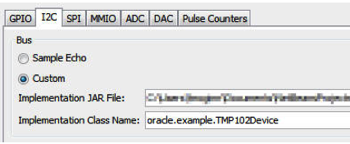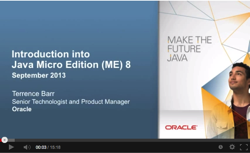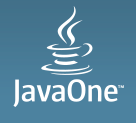You are currently browsing the monthly archive for September 2013.
Monthly Archive
The Internet of Things: Now arriving at OpenWorld
09/26/2013 in Embedded | Tags: business, data, Internet of Things, iot, IT, Java Embedded, Java ME Embedded, Java SE Embedded, M2M | Leave a comment

The Internet of Things has officially arrived in corporate IT. Today’s OpenWorld keynote is all about intelligent devices, the value of data, and the challenges, opportunities, and profound changes the Internet of Things brings to business.
Hear Oracle Chief Corporate Architect Edward Screven and Senior Vice President Chris Baker together with Dr. Thomas Kiessling, Chief Product and Innovation Officer Deutsche Telekom:
Unlocking Innovation and the Value of Embedded Intelligence on Devices
Thursday, 9 am – 10 am, Moscone North Hall D
For more information see here (scroll down to the Thursday agenda).
Cheers,
— Terrence
Java ME 8 Early Access release: Try it out!
09/21/2013 in Embedded | Tags: "Java ME 8", Early Access, embedded, iot, Java Embedded, Java ME Embedded, M2M | 9 comments
Update (9/25): Some users may be experiencing problems when installing the Java ME SDK 8 EA plugins into NetBeans. Please see the updated Java ME SDK 8 EA Release Notes for a workaround.
As I blogged recently, the Java ME 8 specifications are moving full steam ahead. And today, Oracle is announcing the immediate availability of Java ME 8 Early Access.
Java ME 8 in a Nutshell:
Java ME 8 is a significant update of the Java ME platform and provides a modern, flexible, and feature-rich embedded software platform that is aligned with Java SE 8 and allows more efficient development, deployment, and management of embedded software solutions:
- CLDC (Connected Limited Device Configuration) 8: Support for Java SE 8 language features and popular Java SE APIs, an updated virtual machine, and footprint optimizations
- GCF (Generic Connection Framework) 8 (part of CLDC 8): IPv6, enhanced connectivity, new protocols, and support for TLS 1.2
- MEEP 8 (Java ME Embedded Profile) 8: Provides a “services-enabled” application framework, footprint reductions through platform “right-sizing”, dedicated new embedded APIs, and an enhanced security model
- Device I/O API version C: Updated to Java ME 8/SE 8 language support, and new functionality and peripheral support
Java ME 8 Early Access scales down to very small target devices – the single-chip solution used on the STM32F4DISCOVERY board has 192 KB of RAM and 1 MB Flash, and costs around US $5 in volume, yet can host a complete solution of Java ME 8 EA runtime, networking and device access functionality, and Java application.
With this update, Java ME 8 is positioned to be the platform of choice for intelligent devices and the Internet of Things.
To learn more about Java ME 8:
- View the 15 minute webcast “Introduction into Java Micro Edition (ME) 8”
- Browse the full slide deck on “Java ME 8 and The Rise of the Internet of Things”
Getting started with Java ME 8 Early Access:
Java ME 8 Early Access is available now for the following developer boards:
- Raspberry Pi Model B (ARM11/Linux)
- ST Microelectronics STM32F4DISCOVERY (ARM Cortex-M4)
Software development is supported by the Java ME SDK 8 Early Access, which includes a Java ME 8 runtime emulation on Windows as well (so you can get started even without a developer board).
- Learn more and download Java ME 8 Early Access binaries and Java ME SDK 8 Early Access tools
- Access Release Notes and step-by-step Getting Started Guides
Cheers,
— Terrence
JavaOne 2013: Deep into Embedded
09/21/2013 in Embedded, Mobile & Embedded | Tags: embedded, Java Embedded, Java ME Embedded, Java SE Embedded, JavaOne, JavaOne San Francisco, Raspberry Pi | Leave a comment
Embedded @ JavaOne is really coming into its own this year. Lots of cool and relevant topics, content, and activities related to Java and embedded. A quick sampler:
Keynotes:
Be sure to watch the JavaOne keynotes for embedded announcements and some cool demos …
Sessions:
- Java Embedded Extreme Mashups: Building Self-Powering Sensor Nets for the Internet of Things TUT3676]
- Home Automation for Geeks [CON9177]
- Trust Me, I’m an M2M Device [CON7872]
- Is It a Car? Is It a Computer? No, It’s a Raspberry Pi JavaFX Informatics System [CON3243]
- JavaRCX: A Java Embedded Lego Mindstorm RCX Emulator [BOF7901]
- Beyond Beauty: JavaFX, Parallax, Touch, Raspberry Pi, Gyroscopes, and Much More [CON2540]
- Industrial Product Development: Modular Design in Multiple Dimensions with Java [CON2027]
- Performance Tuning and Optimization of Apache Hadoop with Java Embedded on ARM [BOF7216]
- Creating Multidevice Interactive Entertainment for the Living Room with Java [CON9176]
- Controlling NAO Robot with Java [CON11839]
- Java ME 8 Overview: A New Platform for Embedded Development for Small Devices [CON2267]
- and much more … for a full list of sessions, see the Content Catalog.
Internet of Things with Partners:
A summary of various demos, sessions, and activities by Oracle, Eurotech, and Hitachi related to the Internet of Things.
DEMOGrounds:
- A number of demos around embedded use cases, technologies, and solutions by partners across the ecosystem, including the “Device Showcase”
Duke’s Choie Awards:
- Be sure to watch for innovative embedded solutions with Java
Java Embedded Challenge for Raspberry Pi:
- Fun and creative hacking with Raspberry Pi, sensors, and more – equipment and expertise provided.
OTN Lounge and Java Codegarten:
- Hang out with the experts, including specialists in Java Embedded.
For more information on the above, check out the JavaOne Experiences page.
See you in a few days at the show!
Cheers,
— Terrence
Custom I/O devices with Java ME SDK 3.3
09/09/2013 in Embedded | Tags: devices, embedded, GPIO, I2C, Java ME Embedded, Java ME SDK | Leave a comment
 One of the core requirements for embedded Java applications is the ability to access I/O devices, such as sensors, switches, converters, actuators, LEDs, and so on to enable the embedded system to interact with the world around it.
One of the core requirements for embedded Java applications is the ability to access I/O devices, such as sensors, switches, converters, actuators, LEDs, and so on to enable the embedded system to interact with the world around it.
Java ME Embedded includes the Device Access API (DAAPI), which is a comprehensive API that provides access to a range of common I/O devices directly from your Java application in an easy and platform-independent manner. No native code, recompilation, or other “traditional embedded trickery” required.
That works great if you have your target platform already available and up-and-running. But what if you want to start software development before your target platform hardware is available? Or you want to develop most of the code on a Desktop PC for convenience and speed purposes? The Java ME SDK has you covered.
The Java ME SDK offers a set of tools as well as plugins for NetBeans and Eclipse which allow you to develop Java ME Embedded applications efficiently and leveraging your existing Java expertise. Another great feature is that it includes a full emulation runtime which emulates a Java ME Embedded target platform on the PC. Furthermore, the Java ME SDK also includes a tool called the “Custom Device Editor”, which allows you to customize the emulation runtime to your needs (for example, by adding the specific I/O devices of your actual target hardware) and even allows you to implement simulated device behavior (in Java, of course).
To get started with custom I/O devices in the Java ME SDK, check out an excellent blog post Tom McGinn from the Oracle Education Team, explaining how to add and simulate an I2C temperature sensor.
Cheers,
— Terrence
Using Obfuscation with Java ME SDK 3.3
09/05/2013 in Embedded, Mobile & Embedded | Tags: Java ME Embedded, Java ME SDK, NetBeans, obfuscation, ProGuard | Leave a comment
Obfuscation is a really helpful mechanism to reduce the size of your Java ME Embedded application code to a minimum.
When developing Java embedded applications using the Java ME SDK 3.3 with NetBeans you would normally be able to easily install the ProGuard obfuscator via the NetBeans ProGuard plugin and then set it to automatically obfuscate every project build.
However, for NetBeans 7.3 a licensing incompatibly prevents the ProGuard plugin to be available directly on the NetBeans 7.3 update center. This issue has been fixed for the upcoming NetBeans 7.4.
If you want to use ProGuard with NetBeans 7.3 there is an easy workaround described on the NetBeans bug tracker: https://netbeans.org/bugzilla/show_bug.cgi?id=227701. Scroll down to the end of the thread to see:
——————————————–
For now it is possible to use following workaround for proguard: 1. Download proguard.jar from http://sourceforge.net/projects/proguard/files/proguard/ 2. Insert following line in {YOUR_PROJECT_DIR}/nbproject/private/private.properties OR {NB_USERDIR}/build.properties (no need to insert in both): obfuscator.classpath={PATH_TO_proguard.jar} (e.g. obfuscator.classpath=C:\\JavaME\\Proguard\\proguard.jar)
——————————————-
Hope this helps. Cheers,
— Terrence




Recent Comments